kadriver
Hazard to Others
  
Posts: 196
Registered: 7-11-2012
Location: United States
Member Is Offline
Mood: Thankful
|
|
Clean Sulfur Dioxide Gas
I am trying to learn how to produce some clean SO2 gas for precipitating pure gold from an aqueous solution of goldIII chloride.
Apparently the gold atoms in solution have an affinity for the sulfur atoms and collect around the sulfur atoms until they are too heavy to stay in
solution.
The gold atoms then fall (precipitate) to the bottom of the container as pure gold.
This reaction can also be produced by adding a chemical (sodium metabisulfite) to the goldIII chloride solution.
But it is thought that the clean gas, bubbled through the goldIII chloride produces a cleaner precipitation with less drag-down of other metals (if
present in the goldIII chloride solution).
I can get the gas from my gas supplier, but they want a rental fee on the container of $0.50 per day.
I have all the equipment needed to make the gas.
I have found a thread here that talks of making the gas;
http://www.sciencemadness.org/talk/viewthread.php?tid=9398#p...
In this thread a member describes using a metabisulfite and acid to make the SO2 gas.
Can I use sodium metabisulfite (Na2S2O5) mixed with hydrochloric acid to make some clean SO2 gas suitable for clean precipitation of gold from a
solution of goldIII chloride?
Should sulfuric acid be used instead of hydrochloric acid?
Should the gas be scrubbed or cleaned through a bubbler prior to being used to precipitate the gold?
Thank you
kadriver
|
|
|
LanthanumK
Hazard to Others
  
Posts: 298
Registered: 20-5-2011
Location: New Jersey
Member Is Offline
Mood: No Mood
|
|
According to Wikipedia, sulfuric acid can be used to make sulfur dioxide from sodium metabisulfite. I do not believe it is necessary to have the gas
cleaned before use. If the solution is kept cold, sulfur dioxide should dissolve quite well and the reaction should go fine.
hibernating...
|
|
|
garage chemist
chemical wizard
    
Posts: 1803
Registered: 16-8-2004
Location: Germany
Member Is Offline
Mood: No Mood
|
|
If you can actually get the bottled gas from a supplier, consider buying an old medical oxygen or other suitable gas cylinder from ebay and filling
the gas into it to spare yourself the rent for the original SO2 cylinder.
The gas can be liquified by leading it into an externally cooled glass flask. The cylinder to be filled is precooled in the freezer and its valve is
loosened, and when you have accumulated enough liquid SO2, unscrew the valve, pour in the liquid and close the cylinder. A gas mask is recommended for
this operation.
A better method would be to use a refilling bow that connects two cylinders. Since bows with thread fittings for an SO2 and O2 cylinder on each side
are unavailable, you will have to braze this together yourself.
The cylinder to be filled must be evacuated with a vacuum pump prior to filling, otherwise no liquid will condense in it.
It must be cooled with ice during the filling process to aid the flow and condensation of gas.
It is imperative to make sure that the cylinder is not overfilled. The liquid expands upon warming and this may rupture the cylinder if no headspace
is present for the liquid to expand into. The maximum allowable fill is 1kg SO2 per litre of cylinder volume.
|
|
|
Vargouille
Hazard to Others
  
Posts: 380
Registered: 16-4-2012
Member Is Offline
Mood: No Mood
|
|
The reaction between metabisulfite and hydrochloric acid is not dependent on the acid being hydrochloric. The reaction that occurs is firstly
hydrolysis of metabisulfite into two equivalents of bisulfite. The addition of acid leads to protonation of bisulfite to sulfurous acid, which rapidly
decomposes into water and SO2. The only requirement is that the acid is relatively strong, and there are a good many acids, including sulfuric and
phosphoric, that satisfy this. If you wish to simply make a small amount of SO2, you can create a gas generator and lead it into your solution of gold
chloride without much purification needed. The SO2 produced will be contaminated with H2O and HCl if you choose to go that route, but this should not
impact your yields, as the solution of gold is aqueous and contains chloride. If your acid is a significantly less volatile acid such as sulfuric or
phosphoric acid, the only noticeable contaminant should be water.
The reason that SO2 is used is because it reduces gold, a term that means it participates in a reaction that gives up electrons to gold. Once the gold
is reduced to the metallic form, it is insoluble in water and precipitates. The SO2 converts to bisulfite (HSO3-) in water, and is oxidized
to bisulfate (HSO4-) with the reaction.
|
|
|
kadriver
Hazard to Others
  
Posts: 196
Registered: 7-11-2012
Location: United States
Member Is Offline
Mood: Thankful
|
|
Quote: Originally posted by Vargouille  | | The only requirement is that the acid is relatively strong, and there are a good many acids, including sulfuric and phosphoric, that satisfy this. If
you wish to simply make a small amount of SO2, you can create a gas generator and lead it into your solution of gold chloride without much
purification needed. |
This is exactly what I want to do.
I have sulfuric acid and the apparatus to generate the gas.
I have a fume hood to do the experiment in.
What chemical should be combined with the sulfuric acid to make the SO2 gas?
I also have concentrated nitric and hydrochloric acids.
I have made HCl gas by combining rock salt and dripping concentrated sulfuric acid from a seperatory funnel.
I have made hydrogen gas by combining hydrochloric acid and zinc.
But I have never attempted to generate SO2 gas until now.
My question is this; what chemicals do I need to combine in my gas generating apparatus to produce sulfur dioxide gas?
The SO2 gas will be bubbled through the gold chloride solution to precipitate the pure gold powder.
Once I get this question answered, I plan to make a video showing the experiment in detail, then I will post it here for anyone who chooses to view
it.
Thanks to all who have responded.
kadriver
|
|
|
mr.crow
National Hazard
   
Posts: 884
Registered: 9-9-2009
Location: Canada
Member Is Offline
Mood: 0xFF
|
|
You need a sulfite salt + an acid. Use sodium/potassium sulfite/bisulfite/metabisulfite. You can get this at a homebrew wine or beer store
Sulfuric acid isn't volatile so it would be the best. Don't mix the concentrated acid with the solid, dissolve one in water first
HCl would work fine but some HCl gas might come over. For gold chloride this is OK
Never use nitric in place of a normal acid
Double, double toil and trouble; Fire burn, and caldron bubble
|
|
|
kadriver
Hazard to Others
  
Posts: 196
Registered: 7-11-2012
Location: United States
Member Is Offline
Mood: Thankful
|
|
I forgot one other gas:
I have generated chlorine gas by combining trichloroisocyanuric acid (crushed up chlorine pool tablets with a little distilled water) and dripping
concentrated hydrochloric acid from a separatory funnel.
The gas was bubbled through a solution of dissolved palladium to produce ammonia soluble (HN4)2PdCl6.
kadriver
|
|
|
kadriver
Hazard to Others
  
Posts: 196
Registered: 7-11-2012
Location: United States
Member Is Offline
Mood: Thankful
|
|
Quote: Originally posted by mr.crow  | You need a sulfite salt + an acid. Use sodium/potassium sulfite/bisulfite/metabisulfite. You can get this at a homebrew wine or beer store
Sulfuric acid isn't volatile so it would be the best. Don't mix the concentrated acid with the solid, dissolve one in water first
HCl would work fine but some HCl gas might come over. For gold chloride this is OK
Never use nitric in place of a normal acid |
Ok, bravo!
I have several pounds of sodium metabisulfite (used to precipitate the pure gold powder)
I have Rooto Drain Cleaner from Ace Hardware (98% concentrated sulfuric acid).
I'll use these two chemicals to make the SO2 gas for the experiment.
Fantastic forum! Thanks for the great info - video to follow.
kadriver
|
|
|
mr.crow
National Hazard
   
Posts: 884
Registered: 9-9-2009
Location: Canada
Member Is Offline
Mood: 0xFF
|
|
Cool, just keep it nice and simple 
Double, double toil and trouble; Fire burn, and caldron bubble
|
|
|
woelen
Super Administrator
        
Posts: 7976
Registered: 20-8-2005
Location: Netherlands
Member Is Offline
Mood: interested
|
|
I want to add that slightly heating helps a lot. Use metabisulfite (better than normal sulfite) and use 50 to 60% H2SO4 and drip the acid on the
solid. Heat the flask somewhat (60 to 70 C is fine, no need to heat boiling hot). This heating assures that the gas escapes at a good rate, otherwise
the production of the gas is sluggish and the material tends to foam a lot. Some foaming will occur anyway. In this way I have made SO2 several times
and it works fine.
|
|
|
kadriver
Hazard to Others
  
Posts: 196
Registered: 7-11-2012
Location: United States
Member Is Offline
Mood: Thankful
|
|
Ok, add some heat - I had planned on doing this for the reason you gave.
Use dilute H2SO4 - 50% to 60% (adding the acid to the water to avoid spattering hot acid).
Monitor foaming.
I was going to make a slurry of the sodium metabisulfite by adding a few ml of distilled water rather than drop the acid onto the dry powder.
Your recommendation is to drip the acid on the solid Na2S2O5. Is there an advantage to having the chemicals dry? I can see where having it dry would
tend to reduce the foaming.
I plan to have an empty flask between the gas generating flask and the final out put hose to prevent any suck back of the valuable gold chloride
solution.
woelen, thank you for the information you have provided, I value your inputs highly.
kadriver
Edited one time for spelling
[Edited on 31-1-2013 by kadriver]
|
|
|
kadriver
Hazard to Others
  
Posts: 196
Registered: 7-11-2012
Location: United States
Member Is Offline
Mood: Thankful
|
|
Quote: Originally posted by LanthanumK  | | According to Wikipedia, sulfuric acid can be used to make sulfur dioxide from sodium metabisulfite. I do not believe it is necessary to have the gas
cleaned before use. If the solution is kept cold, sulfur dioxide should dissolve quite well and the reaction should go fine. |
I read back through and found that the correct combination of chemicals had already been given - thank you LanthanumK, sorry for hoping over you like
that.
Glad I read it over because I missed an important piece (keeping the solution cool). I will put some ice made from distilled water right in the
goldIII chloride solution. I have done this before to keep the solution cool.
I have had up to seven Troy ounces of gold dissolved in less than a liter of solution. In this situation it is required to cool the solution prior to
precipitating the gold.
If not cooled, the highly concentrated solution could boil over (the precipitation reaction is exothermic), and complete precipitation becomes
difficult.
Icing the solution beforehand eliminates these problem.
Thank you LanthanumK.
kadriver
|
|
|
Endimion17
International Hazard
    
Posts: 1468
Registered: 17-7-2011
Location: shores of a solar sea
Member Is Offline
Mood: speeding through time at the rate of 1 second per second
|
|
If you want clean SO<sub>2</sub>, you should bubble it through concentrated sulphuric acid after which a tube with a glass wool plug is
fitted, to reduce any chances of aerosol coming over.
If you want it squeaky clean, add a phosphorus pentoxide trap between the plug and the acid trap.
If you want it to be really pure, devoid even of dissolved air, you have to freeze it and keep it frozen in vacuum for a few hours. It's a procedure
people do when they work with purged Schlenk lines, for example.
I know you don't need such purities, but as long we're talking about clean gases, I might as well mention it. The first method is fine enough for most
purposes.
|
|
|
kadriver
Hazard to Others
  
Posts: 196
Registered: 7-11-2012
Location: United States
Member Is Offline
Mood: Thankful
|
|
Endimion17, thanks, the more info I can get the better.
If I am trying to get 5 nines pure gold (99.999%), then I may need these tips to help me do it.
For this experiment I am just going with an empty flask between the gas generator and the gold chloride container.
Here are a few photos of the apparatus and the reagents that will be used.
The last photo is the pure gold button I will be using. It weights about 16 grams and it has already been refined to about 99.5% purity.
I will granulate this button by melting it and pouring the molten gold into a stainless steel container of cold tap water.
I'll collect the resulting granules of gold, rinse them with distilled water, and then dissolve them with aqua regia for the experiment.
I'll make a detailed video and post it soon - This is great fun!
kadriver
kadriver
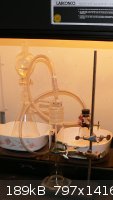
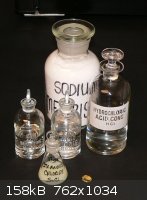

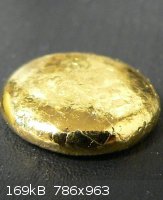
|
|
|
Vargouille
Hazard to Others
  
Posts: 380
Registered: 16-4-2012
Member Is Offline
Mood: No Mood
|
|
Note that the contaminants that would come over with the SO2 if your acid is HCl or H2SO4 are either already contained in the solution or would be a
result of the reaction, so purification of the SO2 is largely unnecessary. Other reactions may need quite pure SO2, but this is not one of them.
Now, I am familiar with the chemicals required for aqua regia, and the use of metabisulfite as an SO2 source, but what is the use of the stannous
chloride?
|
|
|
kadriver
Hazard to Others
  
Posts: 196
Registered: 7-11-2012
Location: United States
Member Is Offline
Mood: Thankful
|
|
The stannous chloride is used to detect slight traces of dissolved gold in a solution.
When I bubble the SO2 gas through the goldIII chloride solution, I can tell when most of the gold has precipitated by the change in color of the
solution. it will go from a dark yellow/orange color to nearly water-clear.
But, the only way to be certain that ALL the gold has precipitated is to retreive a drop of the solution from the reaction container, place it on a
piece of filter paper, then add a drop of the stannous chloride test solution.
If ANY gold remains in solution, then the test will turn a shade of purple. Dark purple means much gold in solution, light purple means a trace of
gold still in solution. If the test turns any shade of purple, then more SO2 gas will need to passed throught the solution to get all the gold to
"come down".
If all the gold has precipitated, then there will be no color change at all.
The test is very sensitive and can detect even trace amounts of dissolved gold.
Here is a video that shows how the test solution is used, fast foward to 3:20 on the video to skip right to the test;
http://www.youtube.com/watch?v=HNq3Tp99XOE
The SnCl test solution can be made by dissolving 1/2 gram of pure tin metal in a few ml of hydrochloric acid then adding an equal amount of distilled
water - but this does not last very long and goes bad if not used within in a few days.
The SnCl test solution I was taught to make lasts for several months, the recipe is as follows;
1.2 grams stannous chloride crystals
1.2 grams pure tin metal
25ml distilled water
30 drops of hydrochloric acid
The test solution, after mixing, is ready to use immediately.
It is relatively clear for a few days, but gets cloudy over time, then turns milky after a couple of weeks - I put the date of preparation right on
the bottle.
I used a standard test solution of 0.1 grams of pure gold powder dissolved in 100ml of solution to test my stannous chloride test solution.
This chemistry business is cool stuff!
kadriver
|
|
|
kadriver
Hazard to Others
  
Posts: 196
Registered: 7-11-2012
Location: United States
Member Is Offline
Mood: Thankful
|
|
Here is a shot of my standard test solutions; Gold, Palladium, and Platinum.
I tried to get as close as I could to 100mg in 100ml of solution.
To make the platinum I used a 0.1 gram piece cut from a Credit Suisse 1 troy ounce bar.
The platinum took over 6 hours of boiling in HOT aqua regia with fresh additions to dissolve. Even after all that there was a tiny thread of metal
left that did not dissolve.
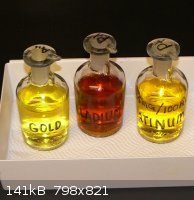
|
|
|
kadriver
Hazard to Others
  
Posts: 196
Registered: 7-11-2012
Location: United States
Member Is Offline
Mood: Thankful
|
|
I granulated the 16 gram gold button this evening.
After granulating the metal by pouring the molten gold into a tub of cold water, I rinsed it and put it in a clean 250ml beaker.
Then I added 100ml of concentrated hydrochloric acid and put it on medium heat.
Once it heated up a little, I turned the heat down and began to add small amounts of 68% concentrated nitric acid to make the aqua regia, 3ml at a
time.
I added a total of about 10ml of nitric acid - this should be enough to just dissolve the pure gold without having an excess of nitric that must be
removed.
I also shot some video so I can make a detailed presentation of the entire experiment.
I left the solution on low heat in my fume hood - over night should be enough time to completely dissolve the 16 grams of pure gold with about 10ml of
nitric acid.
kadriver
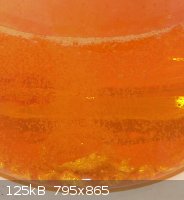 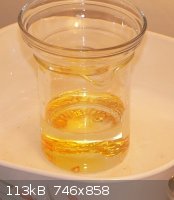
|
|
|
kadriver
Hazard to Others
  
Posts: 196
Registered: 7-11-2012
Location: United States
Member Is Offline
Mood: Thankful
|
|
Here is a great article on the apparatus and chemicals needed to make SO2.
The article says that the gas will contain moisture so bubbling through concentrated sulfuric acid will be needed to remove the moisture (just like
Endimion17 said).
http://books.google.com/books?id=fCYDAAAAMBAJ&pg=PA52&am...
kadriver
|
|
|
woelen
Super Administrator
        
Posts: 7976
Registered: 20-8-2005
Location: Netherlands
Member Is Offline
Mood: interested
|
|
The article talks about conc. H2SO4 and Cu, but the reaction between moderately conc. H2SO4 and Na2S2O5 is much more convenient. The reaction with Cu
requires more heating, 96% H2SO4 and a large excess amount of acid. The only advantage is that the gas is more dry than with the 50% H2SO4/Na2S2O5
method. But for your gold experiment this does not matter at all.
|
|
|
kadriver
Hazard to Others
  
Posts: 196
Registered: 7-11-2012
Location: United States
Member Is Offline
Mood: Thankful
|
|
woelen, I agree with you. The dilute H2SO4 dripped on the dry Na2S2O5 seems less messy. I do plan to add a bubbler flask with concentrated sulfuric
acid between the gas generator and the gold III chloride reaction vessel since I am trying to remove contamination from the gold.
Allowing moisture to get to the gold III chloride reaction vessel provides a path for contaminants (even though this is highly unlikely). Adding a
dryer (conc H2SO4 bubler) can't hurt and may help.
By the way, after dissolving the gold in aqua regia and before filtering, I will add about 10 drops of concentrated sulfuric acid to the gold III
chloride solution.
This is done to precipitate out any lead that might have made it in with the gold. I add the sulfuric even though I am quite certain that the gold
button was relatively pure and probably contained NO lead to begin with.
The H2SO4 will not hurt the process at all. But lead, even in tiny trace amounts, kills the ductility of the gold. Lead makes the gold brittle, the
sulfuric acid easily and completely removes any lead.
The H2SO4 will precipitate any lead in the gold III chloride as insoluble lead sulfate. This lead sulfate can then be easily filtered, leaving the
gold III chloride solution lead free.
Sorry, I have a tendency to tell my life story when I get started with these explanations. The whole point of all this is to confirm the fact that all
these substances, Na2S2O5, H2SO4, water, and SO2 gas are all constituents of this process and will not harm the precipitation reaction at all.
I am really looking forward to getting to my shop this morning.
kadriver
|
|
|
kadriver
Hazard to Others
  
Posts: 196
Registered: 7-11-2012
Location: United States
Member Is Offline
Mood: Thankful
|
|
As promised, here is the video showing the use of SO2 gas to precipitate gold from a gold chloride solution.
I had a slight mishap during the experiment; the gas tube got plugged up with gold powder, stopping the flow of gas to the gold chloride solution.
Its on the video - hope you enjoy it!
kadriver
http://www.youtube.com/watch?v=1Usv2Lh10nQ
|
|
|
davidmichaud
Harmless

Posts: 2
Registered: 18-2-2016
Member Is Offline
Mood: No Mood
|
|
The SO2 Manufacturing Process is “simple”, all you need is a sulfur burning plant. The flowsheet represent what you need for a sulfur burning
system to produce SO2. The manufacturing of 1 metric tonne per day of SO2 requires a sulfur-burning SO2 plant capable of smoking-up around 46 lb/hr
(21 kg/hr) of sulfur to produce 92 lb/hr (42 kg/hr, or ~1 MT/D) of SO2 (Gas at 15%)
|
|
|